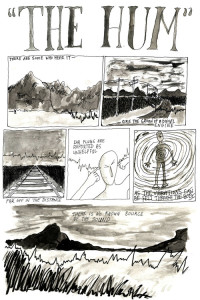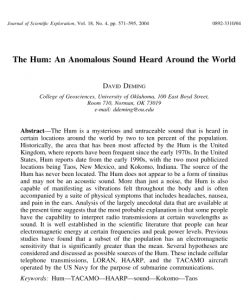Taos Hum
 Sometimes a phenomenon exists, and yet it doesn’t. People keep reporting it. “Your imagination,” say researchers, who can’t locate a thing. It can be animals or flying objects or lights or sounds…Do they exist, or don’t they?
Sometimes a phenomenon exists, and yet it doesn’t. People keep reporting it. “Your imagination,” say researchers, who can’t locate a thing. It can be animals or flying objects or lights or sounds…Do they exist, or don’t they?
For years, in the Taos, New Mexico area many folks have reported hearing a distant, underlying hum. A sort of roar from the earth, or beyond. Yet attempts to record or reproduce or track the sound have proved elusive. Frustrating, or fascinating, or deliciously mysterious, depending upon your point of view. Which scientists are most needed to pursue the mystery: sound engineers, geologists, doctors trained in psychiatry?
We begin our exploration of the sound that isn’t, but is. The Taos Hum.
SOMETHING THAT REALLY HAPPENS, BUT DOESN’T
Can you imagine being able to hear something that’s causing distress, creating insomnia, abrupt nosebleed, or even loss of sex drive– on top of that all of your friends are telling you that it’s just your imagination? Welcome to the world of the Taos Hum.
The hum was first reported several decades ago. From a survey of residents of Taos, some 2 percent of the population was reported to be “hearers.” Special equipment was set up in the residences of these hearers, measuring sounds and vibrations but after substantial testing nothing unusual was detected.
 Interestingly there was not a single identifiable Taos Hum but several different ones; some describe it as whir, hum, motor running or just a giant white-noise machine. The discovery that not everyone heard the same thing was the biggest mystery, and suggests that they may have been reporting subjective individual experiences instead of objective sounds. The more research that was done, the more baffling the phenomenon became.
Interestingly there was not a single identifiable Taos Hum but several different ones; some describe it as whir, hum, motor running or just a giant white-noise machine. The discovery that not everyone heard the same thing was the biggest mystery, and suggests that they may have been reporting subjective individual experiences instead of objective sounds. The more research that was done, the more baffling the phenomenon became.
One of the major challenges in this research spring from an uncanny phenomenon–our ears sometimes create their own noises. Often, these sounds are so subtle we don’t hear them absent extreme quiet or unless we intentionally listen purposefully. Now well-documented are “spontaneous otoacoustic emissions,” a characteristic of the inner ear itself and distinct from disorders such as tinnitus, which causes a ringing in the ears.
But why the fact that only a small percentage of the people heard the Hum? Is it psychological, is it atmospheric anomalies, due to increasing electronic emissions are myriad wave frequencies? We’re not sure.
A serious information and perspective source available online as “theconversation.com” bills itself as built on “academic rigor,” leavened by “journalistic flair.” In 2016 their article “Cracking the Mystery of the Worldwide Hum” reminds us that the phenomenon of the “hearers” of this low drone ranges far beyond Taos, N.M., indeed this writer began hearing his unsettling sounds on Canada’s northwestern coast.
An opening excerpt:
The noise usually started later at night, between 10 and 11 p.m. My first clue that something unusual was happening came with the realization that the sound didn’t fade away, like plane noises typically do. And the slightest ambient noise – exhaling audibly, even turning my head quickly – caused it to momentarily stop. One night after the sound started I stepped outside the house. Nothing.
I was the only person in the house who could hear it; my family said they didn’t know what I was talking about.
Naturally, I assumed something in the house was the culprit, and I searched for the source in vain. I even ended up cutting the power to the entire house. The sound got louder.
While I couldn’t hear the sound outdoors, I could still hear it in my car at night with the windows closed and the ignition off. I drove for miles in every direction, and it was still there in the background when I stopped the car. I was able to rule out obvious sources: industrial activity, marine traffic, electric substations and highway noise.
When I searched on the internet for “unusual low-frequency humming noise,” I soon realized that others had conducted the same search. I was part of the small fraction of people who can hear what is called the “Worldwide Hum” or, simply, the “Hum.”
The questions motivating me and thousands of others were the same: “What’s causing this? Can it be stopped?”
The classic description of the Hum is that it sounds like a truck engine idling. For some, it’s a distant rumbling or droning noise. It can start and stop suddenly or wax and wane over time. For others, the Hum is loud, relentless and life-altering.
Most people have some experience with how disruptive some types of noises can be, which is why there are often noise ordinances in many cities and towns, especially at night. There are many sufferers who dread the nighttime because of how loud and relentless the Hum can be. The Hum database is replete with descriptions of desperate people who have been tormented by the noise for years. The phrase “driving me crazy” is all too common. (I feel fortunate that, in my case, the Hum is more of a curiosity than it is an irritant.)
Glen MacPherson, the conversation.com, June 20, 2016
Senior Editors from MO Mystery have passed through Taos, N.M., and cocked an ear out for the legendary, mysterious drone, and…nothing. Apparently, it’s in the category of so many physical (and psychological) phenomena–some people are wired that way, and some aren’t. But for the one out of fifty, the sound is real, and compelling if not disturbing. And for the rest of us, the question is still intriguing. The scientific Sherlock has something to look into…but how do you gather data, experiment, come to conclusions?
How do you get to the bottom of the sound, a widely heard sound, but only by that occasional person “gifted” enough to encounter it? It will spawn lots of theories, and their quality will vary widely.
Given the need for disciplined inquiry into the phenomenon, in late 2012 I started The World Hum Map and Database Project. The database gathers, documents and maps detailed and anonymous information from people who can hear the Hum. It provides raw data for research in a strictly moderated and serious forum for research and commentary, while providing a sense of community for people whose lives have been negatively affected by the Hum.
Glen MacPherson, the conversation.com, June 20, 2016
YouTube has little visual to “show” about the Hum, but a number of mini-documentaries nonetheless.
We’re interested in this one, 43 seconds of the Hum and nothing else. But, if you can’t really hear or capture this Hum through equipment, only through the occasional human ear, how in the world can they be putting this sound, online, for us to listen to? Another audio-only YouTube posting offers 12 hours, yes a full 12 hours, of the Hum sound (and the audible sound track is pretty similar to the 43 second one).
And for extra aural enlightenment on the side, one short Tube posting offers a test–we start out with a sound at 80 hertz, and slowly go all the way up to about 17 kilohertz, letting you find out what your hearing range within all that is. (Our editor could hear 80 hertz just fine, and all the way up to about 12 kilohertz, but not much beyond that.)
Still another YouTube audio plays you a 60 hertz sound for a solid hour, saying it’s what “a power line frequency sounds like.” Unfortunately, we can hear that sound as well, but a few seconds of it is all we need…that’s to say, having to listen to that all day would be much worse than any punishment we can think of.
We wonder if the actual Hum is anything like that, as experienced by most “hearers.”
WILL SCIENCE AND RESEARCH BRING AN ANSWER?
The article introduced in the previous section reveals much more than one man’s aural experience–he confronts the matter as a scientist and University Lecturer, an expert in what you might even call the emerging field of “Hum Studies.”
 I eventually came across one of the few serious papers on the topic. It was written in 2004 by geoscientist David Deming (who’s also a Hum hearer). Deming began by describing the standard history: The Hum was first documented in the late 1960s, around Bristol, England. It first appeared in the United States in the late 1980s, in Taos, New Mexico. He then examined the competing hypotheses for the source of the Hum. Many have pointed to the electric grid or cellphone towers. But this theory is dismissed on two grounds: cellphones didn’t exist in the 1960s, and the frequency emitted by both cell towers and the electric grid can be easily blocked by metal enclosures. He wondered whether mass hysteria was to blame, a psychological phenomenon in which rumor and “collective delusions” lead to the appearance of physical ailments for which there’s no medical explanation. The fact that so many people have researched the Hum on their own, using a search engine – rather than hearing about it from some other person – moves the conversation away from delusion and hysteria spread by word of mouth. …… The first hypothesis – argued by Deming and the one I’m currently pursuing – is that the Hum is rooted in Very Low Frequency (VLF) radio transmissions. It’s increasingly accepted now that the human body will sometimes experience electromagnetic (EM) energy and interpret it in a way that creates sounds. This was established for high-frequency EM energy by the American neuroscientist Alan Frey in his infamous “microwave hearing” experiments, which showed that certain radio frequencies can actually be heard as sounds. Today, there are biophysical models that predict and explain the impact VLF EM energy has on living tissue. I have designed and built a VLF radio blocking box that should be able to test whether VLF radio frequencies are a prerequisite for generating the Hum.
I eventually came across one of the few serious papers on the topic. It was written in 2004 by geoscientist David Deming (who’s also a Hum hearer). Deming began by describing the standard history: The Hum was first documented in the late 1960s, around Bristol, England. It first appeared in the United States in the late 1980s, in Taos, New Mexico. He then examined the competing hypotheses for the source of the Hum. Many have pointed to the electric grid or cellphone towers. But this theory is dismissed on two grounds: cellphones didn’t exist in the 1960s, and the frequency emitted by both cell towers and the electric grid can be easily blocked by metal enclosures. He wondered whether mass hysteria was to blame, a psychological phenomenon in which rumor and “collective delusions” lead to the appearance of physical ailments for which there’s no medical explanation. The fact that so many people have researched the Hum on their own, using a search engine – rather than hearing about it from some other person – moves the conversation away from delusion and hysteria spread by word of mouth. …… The first hypothesis – argued by Deming and the one I’m currently pursuing – is that the Hum is rooted in Very Low Frequency (VLF) radio transmissions. It’s increasingly accepted now that the human body will sometimes experience electromagnetic (EM) energy and interpret it in a way that creates sounds. This was established for high-frequency EM energy by the American neuroscientist Alan Frey in his infamous “microwave hearing” experiments, which showed that certain radio frequencies can actually be heard as sounds. Today, there are biophysical models that predict and explain the impact VLF EM energy has on living tissue. I have designed and built a VLF radio blocking box that should be able to test whether VLF radio frequencies are a prerequisite for generating the Hum.
Glen MacPherson, the conversation.com, June 20, 2016
MacPherson is interested as well in exploring whether the ultra-low sounds might emanate from the earth–be geologically rather than electronically driven. And he concedes, as well, the possibility that they emanate in some way from the human body itself.
For all mysteries, there are explanations that are more interesting, more creative, others that follow the straight line of Occam’s Razor. Which do you prefer for the Hum?
We truly doubt the “mating fish” hypothesis, and ones involving aliens–although Taos and the other centers of Hum-hearing are all attractive places to spend time on planet earth if you’re coming from a few million light years away.
Given how sensitive the sense of hearing in humans is, how frequency-based and yet unpredictable, there’s a lot to suggest the theories that focus on varying reactions to Ultra Low Frequency vibrations. Will enough testing prove that hypothesis? Stand by.
Remember that there’s more than one Hum, in other words there might be different science at play in different locations. Around northern New Mexico they”ll remind you how “extremely thin” the crust of the earth is there, and of the volcanic activity in local geological history. Other locations note how close they are to military installations that experiment with low frequency transmission to submarines and the like. It may well be the case that several Hums are heard around the world, driven by different vibrations.
And don’t forget, a social and psychological mystery lives inside the scientific one. Why do we assume that something we don’t experience, personally, doesn’t even really exist?
But can we assume that the power of imagination does not also figure into the experience of the “hearers?”
Is it science, or a mixture of science and psychology that produces what we call “The Taos Hum?”
Here’s a video for the specifically New Mexican phenomenon, and another that broadens it a bit:
RESEARCH BOARD
In addition to the data-bases such as Glen MacPherson’s that gather testimony on the Hum phenomenon worldwide, we also open our site to postings on the topic.
Any truly relevant information and perspective is welcome.




